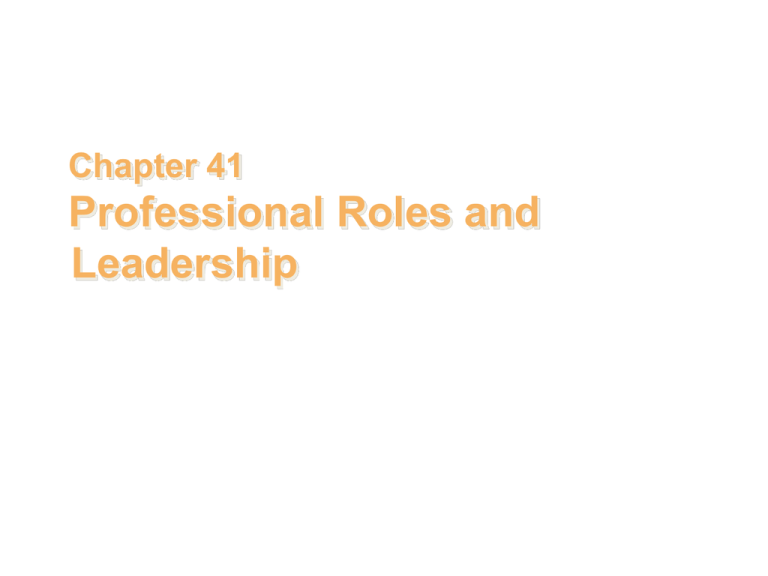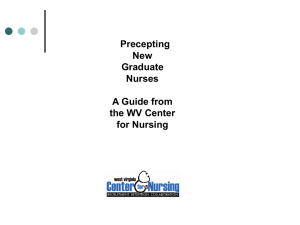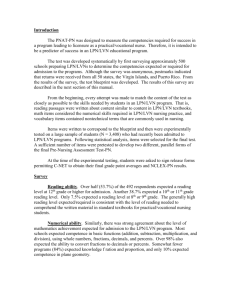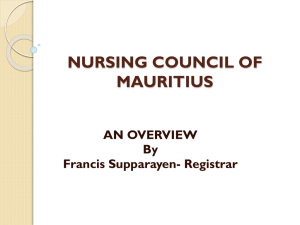
Chapter 41
Professional Roles and
Leadership
Functioning as a Graduate
• The role of a graduate nurse will be exciting
and challenging.
• The LPN/LVN is a valuable member of the
health care team and functions in many
settings.
• Many opportunities are available from which
to choose.
Functioning as a Graduate
• Letter of Application
– It should always be customized, brief, neatly
typed, and correctly spelled.
– It should be simple and direct.
– Its objective is to introduce yourself, announce
your interest in employment, briefly state your
qualifications, and express your availability.
– Your cover letter requires a thorough discussion of
your qualifications.
Functioning as a Graduate
• Résumé
– A summary of educational and professional
experiences, including activities and honors
– A one- or two-page written document that
contains certain information about you, your
education, and your experience
– Should be well-organized, neat, and accurate
Functioning as a Graduate
• Personal Interview
– A meeting of people face to face, as for evaluating
or questioning a job applicant
– First impressions have a lasting effect.
• Contracts
– A promise or a set of promises between two or
more people that creates a legal relationship
between them and a legal obligation that one or
more of them must fulfill
– May be written or oral
Functioning as a Graduate
• Keeping Your Job
– Keep current and competent.
– Look and act professional.
– Be on time and ready to start at the beginning of the
shift.
– Be organized.
– Do not spend time with personal telephone calls.
– Take only the time allocated for lunch and breaks.
– Work hard and give the best care possible.
– Be a good leader and a good follower.
Functioning as a Graduate
• Keeping Your Job
– Help others when you can.
– Stretch yourself; do not be satisfied with the
minimum.
– Display a positive attitude and flexibility.
– Respect your patients, their family members, your
co-workers, and your supervisors.
• Encountering Problems
– Follow the chain of command.
– Be calm and positive in your approach.
– Listen carefully.
Functioning as a Graduate
• Advancement
– A rise in rank or importance, a promotion,
progress, improvement
– May result from additional preparation or
additional experience
– Usually based on a person’s qualifications,
behavior, performance, and preparation
• Terminating Employment
– A verbal statement and letter of resignation
should be completed; proper procedures should
be followed.
Welcome to Leadership!!!
• What direction do you believe nursing is headed in?
• What role will L.P.N.’s play in this role?
• How will you personally participate in this change?
Where do you want to participate?
Transition from Student to Graduate
• Know Your Role
– LPN/LVN is responsible to the RN or physician.
– Role of LPN/LVN is constantly changing.
• Technical and scientific changes in the health care
system have resulted in a multiplicity and complexity of
functions placed on the nurse.
• Be careful not to lose sight of your principal concern—
the patient, a human being!
Transition from Student to Graduate
• Confidentiality
– All information the patient gives is confidential.
– Information may be exchanged with other
members of the health care team only in the
performance of your duties.
– Releasing any information to anyone other than
the health care team without the consent of the
patient is a violation of the right to privacy.
Transition from Student to Graduate
• Role of the LPN/LVN in the Community
– Participates in activities that promote the
community’s attitude toward positive health care
– Uses community resources to promote a better
understanding of the health services available to
the general public
– Participates in community health projects and
other health-oriented activities
Transition from Student to Graduate
• Professional Organizations
– Gives you a voice in your profession
– Some provide continuing education
– Two national organizations are designed to
support and meet the needs of the LPN
• National Association for Practical Nurse Educators
(NAPNES)
• National Federation of Licensed Practical Nurses
(NFLPN)
– National League for Nursing (NLN)
• Involved with all types and levels of nursing
Transition from Student to Graduate
• Continuing Education
– It is critical to keep current on nursing trends and
issues.
– There are many opportunities for nurses to learn
new nursing skills.
• Facilities offer employees continuing education.
• Internet
• Some states require CEUs before you can renew nursing
licenses.
Transition from Student to Graduate
• Certification Opportunities
– Certifications
•
•
•
•
•
Managed care (CMCN)
Pharmacology
Long-term care (CLTC)
Addiction (CALPN)
Further education
Licensure Examination
• National Council of State Boards of Nursing
– The computerized adaptive testing (CAT) was
adopted in 1994.
– Examinee takes the CAT exam by sitting at an
individual computer and answering questions on
the screen.
– NCLEX-PN has 85 to 205 questions.
• The candidate’s application is approved by the
board of nursing in the jurisdiction where the
NCLEX is to be taken.
• On successful completion of the examination,
you can practice as an LPN/LVN.
Licensure Examination
• Endorsement/Reciprocity
– This is recognition of the license of a health
practitioner in one state by another state.
– Applicant must meet the state’s licensing
requirements.
– If the nurse travels with a patient from one state
to the other or to Canada, the license the nurse
has in her or his possession is valid for the length
of the stay in the other state or Canada.
Licensure Examination
• Nurse Licensing Compact/Mutual Recognition
– Based on the primary state of residence.
• A declared, fixed, permanent, and principal home for legal
purposes
– A nurse may practice in a compact state using the
nursing license from the primary state of residency.
– State boards of nursing differ, so you should contact
the board of nursing in the state where you are
seeking licensing for the specific requirements.
Nurse Practice Act
• Licensing law
• Defines the title and regulations governing the
practice of nursing
• Assists the nurse in staying within the legal scope
of nursing practice in each state
• Defines the regulations for practical nursing and
includes requirements for an approved school of
nursing
• Defines requirements for licensure and
conditions for which a license may be revoked or
suspended
State Board of Nursing
• Board consists of members who represent
different levels of nursing and are appointed by
the governor.
• The purpose of the board is to protect the public
by administering the nurse practice act.
• Board is responsible for approving schools of
nursing
• Board issues and renews licenses.
– Board has the authority to suspend or revoke a
license.
Career Opportunities
• Hospitals
– LPN/LVN is under the supervision of the RN.
– LPN /LVN is legally able to provide most bedside
care to patients in the hospital setting.
– LPN /LVN is responsible for supervising the nursing
assistants.
– There are a number of different types of hospitals.
Figure 41-5
(From Polaski, A.L., Warner, J.P. [1994]. Saunders fundamentals for nursing assistants. Philadelphia:
Saunders.)
Various positions are available in the hospital setting on the health care
team.
Career Opportunities
• Long-term Care Facilities
– LPN/LVN is the backbone of long-term care facilities
– Can advance to charge nurse and supervisory capacity
with RN supervision
– A facility for those who require long-term care
• Home Health
– Health care in the home setting
– RN supervision must be available
– Relaxed atmosphere, decreased patient load,
primarily daytime hours
Career Opportunities
• Physician’s Office or Clinic
– Some of the skills required may not be included in
the LPN/LVN educational program.
• Laboratory testing, ECGs, computer skills, insurance
coding, billing, supervision of other office personnel
• Insurance Companies
– Preadmission and claims assessments
– Usually require experience in medical-surgical
nursing
Career Opportunities
• Temporary Agencies
– These agencies provide nurses to meet the staffing
needs in a variety of health care facilities.
– Advantages are the right to refuse and the wealth of
variety available.
– Disadvantage is the uncertainty of work available.
• Travel Opportunities
– Nurse can work for specified periods in areas in need
of nurses through a temporary agency.
– Experience is required.
– Lodging is provided in addition to salary.
Career Opportunities
• Pharmaceutical Sales
– LPN/LVN makes contacts with physicians, pharmacists,
and nurses in various clinical settings.
• Presents the advantages of products
• Teaches about side effects and precautions
– Experience in specific areas and an expertise in
science and pharmacology are required.
• Other Medical Sales
– Sell medical supplies
– May perform in-service programs at facilities to
demonstrate product use
Career Opportunities
• Outpatient Hotels
– Provides patient teaching and assists with preparation
for tests; available for emergencies
– Hotel is usually owned by a hospital.
• Patient/guests stay while they undergo testing before
surgery and/or for postsurgical care.
• The Military
– Active duty or reserves are options.
– Educational opportunities
• Additional education
• May help repay loans
Career Opportunities
• Adult Day Care
– Provide medical supervision for adults while their
family members work or take a break from the
responsibility of care
• Schools
– Perform health screenings, emergency care, and
health teaching
• Public Health
– Work in clinics and home visits; may also participate in
health inspections
Career Opportunities
• Outpatient Surgery
– Prepare patients for surgery, as a scrub nurse, or to
work in the recovery room under the supervision of
an RN.
• Private Duty
– Give total care to one patient
– May be in the hospital, home, other facility, or while
traveling
• Government
– May work in a Veterans Administration hospital or
other government hospitals
Career Opportunities
• Industrial
– Focuses on promoting wellness and preventing
accidents
– Safety is emphasized, and usually is first aid–oriented.
– May do physical assessments, health surveys,
insurance forms preparation, health education, and
intervention for patients injured in industrial accidents
• Rehabilitation
– Guides the patient toward health and independence
Career Opportunities
• Psychiatric
– Provides care for the mentally ill patient
– Requires a mature person
• Hospice
– Provides care for the terminally ill patient
– Institution or home setting
– Must have a clear understanding of his or her own
feelings about death
Leadership and Management
• Leadership
– The art of getting others to want to do something
you are convinced should be done
• Management
– Handles the day-to-day operations to achieve a
desired outcome
Leadership and Management
• Leadership is important in determining the
effectiveness of an undertaking
• “Styles” refer to the approach or manner a
leader uses to influence others
– Styles relate to the amount of control or freedom
the manager allows the group
– Styles range from total control by the manager to
extreme permissiveness
Leadership and Management
• Autocratic Style
– Retains all authority and responsibility
– Concerned primarily with tasks and goal
accomplishment
– Assigns clearly defined tasks
– Establishes one-way communication with the
group
– Excels in times of crisis (cardiac arrest) and in
situation of disorder (natural disasters)
Leadership and Management
• Democratic Style
– People-centered approach
– Allows employees more control and participation
in the decision-making process
– Emphasis is on team building and collaboration
– Works best with mature employees who work well
together as groups
Leadership and Management
• Laissez-Faire Style
– “Free-run style” or permissive leadership
– Relinquishes control completely
– Chooses to avoid responsibility by delegating all
decision making to the group
– Wants everyone to feel free to “do their own
thing”
– May work well with highly motivated professional
groups
Leadership and Management
• Situational Leadership
– Takes into account the style of the leader, the
maturity of the group, and the situation at hand to
form a comprehensive approach
– Four typical styles
• Directing
– Provides specific instructions and supervises the
accomplishment of tasks
– New employees, employees with repeated performance
problems, and crisis work situations
Leadership and Management
• Situational Leadership (continued)
– Coaching
• Monitors the accomplishment of tasks while also
explaining decisions, asking for feedback or
suggestions, and recognizing good performance
• Typically, leader and staff have have jointly developed a
work plan.
Leadership and Management
• Situational Leadership (continued)
– Supporting
• Supports the efforts of others, facilitates their goal
accomplishment, and shares responsibility for decision
making
• Values growth and not perfection, collaboration and
not competition
– Delegating
• Gives responsibility for decision making and problem
solving to mature staff who have demonstrated their
competence
Leadership and Management
• Team Leading
– Assisting and guiding the nursing team in
providing care for a select group of patients
– Duties
•
•
•
•
•
Receive reports on assigned patients
Make assignments for team members
Make rounds and assess all assigned patients
Assist in administering medications and treatments
Confer with team members on priority patients
Leadership and Management
• Time Management
– Using time to good advantage will be of great
value.
– Learn effective time management skills, and
practice them frequently until they become fully
developed.
– These skills will help you manage not only at work
but also in daily living.
Leadership and Management
• Anger Management
– Anger gives you a cue that something is wrong.
– Justified
• Helps you get your needs met by stimulating you to
action
– Unjustified or displayed inappropriately
• Can get you and others in trouble
– See Box 41-11 (p.1258) Personal Anger
Management Techniques
Leadership and Management
• Burnout
– Physical, emotional, and spiritual exhaustion
– Nurses are at high risk because they care!
– Occurs more often in people who have excessively
expectations of themselves
– High-risk areas
•
•
•
•
Intensive care
Hospice
Oncology
Emergency department
Leadership and Management
• Burnout (continued)
– Signs and symptoms
• Physical
– Fatigue; changes in sleeping and eating
– Lack of energy; loss of interest in sex
• Psychologic
– Irritability; hypersensitivity
– Frustration; negative outlook
– Forgetting
• Spiritual
– Loss of commitment, meaning, and integrity
Figure 41-7
Symptoms of burnout.
(From Arnold E.N., Boggs, K.U. [2003]. Interpersonal relationships: professional communication skills for nurses. [4th
ed.]. Philadelphia: Saunders.)
Leadership and Management
• Strategies for Burnout Prevention
–
–
–
–
–
–
–
–
–
Awareness
Balance
Choice
Detachment
Altruistic egoism
Focus
Goals
Hope
Integrity
Leadership and Management
• Transcribing Physicians’ Orders
– Written
• Recorded on the chart by the physician.
• NEVER GUESS: If in doubt, get a second opinion.
• If it is a little different than “usual,” clarify it with the
physician.
• If you still believe the orders to be inappropriate,
contact your supervisor and document why the orders
are not being carried out.
Nurses are responsible for their own actions regardless
of who told them to perform those actions.
Figure 41-8
(From Leahy, J.M., Kizilay, P.E. [1998]. Foundations of nursing practice: a nursing process approach. Philadelphia:
Saunders.)
Clarifying the physician’s order.
Leadership and Management
• Transcribing Physicians’ Orders (continued)
– Verbal or via telephone
•
•
•
•
•
•
They may only be taken from a physician or a nurse.
They are more subject to error.
Clarify the order by repeating it to the person giving it.
Ask them to repeat it more slowly if necessary.
Write it down immediately.
Be careful about medications that sound alike.
– For example, Zantac and Xanax
P. 1261 Medication Safety Alert – Precautions for
Transcribing orders
Figure 41-10
(From Elkin, M.K., Perry, A.G., Potter, P.A. [2004]. Nursing interventions and clinical skills. [3rd ed.]. St.
Louis: Mosby.)
Computerized system for narcotic distribution.
Leadership and Management
• Change of Shift Report
– The report provides the next shift with pertinent
information about the patient.
– The quality of nursing care the patient receives is
contingent on how well each shift communicates with
the other.
– The report may be given orally in person, by
audiotape recording, or with rounds from patient to
patient.
– Before beginning the report, write down all necessary
information.
Figure 41-11
(From Elkin, M.K., Perry, A.G., Potter, P.A. [2004]. Nursing interventions and clinical skills. [3rd ed.]. St.
Louis: Mosby.)
Giving a change-of-shift report.
Delegation
• Refers to the act of making another person
responsible for a specific task
• Involves clearly communicating all aspects of
the delegated care to the person completing
the task
• The staff member performing the care has to
be able to perform tasks independently and
have the ability and knowledge to complete
the tasks.
Computers in Health Care
• Technology for voice-activated charting;
customized nursing careplans; assessment of
acuity levels; tx/med reminders; developing
clinical pathways and maps; and researching
drug/food incompatibilities
• Challenge: maintaining confidentiality and
protect the integrity of the system










